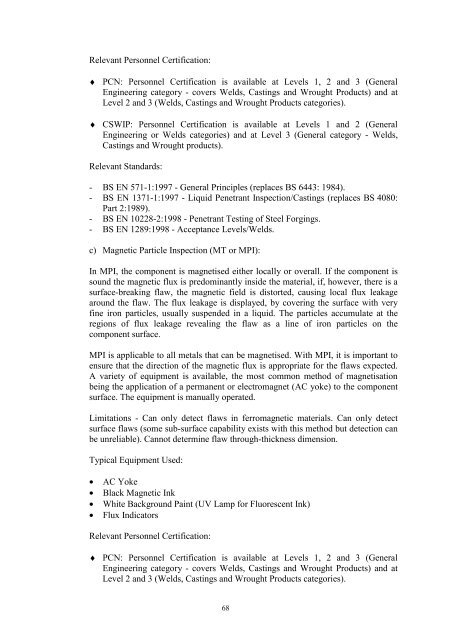Best Practice for Risk Based Inspection
risk based inspection
risk based inspection
You also want an ePaper? Increase the reach of your titles
YUMPU automatically turns print PDFs into web optimized ePapers that Google loves.
Relevant Personnel Certification:<br />
♦ PCN: Personnel Certification is available at Levels 1, 2 and 3 (General<br />
Engineering category - covers Welds, Castings and Wrought Products) and at<br />
Level 2 and 3 (Welds, Castings and Wrought Products categories).<br />
♦ CSWIP: Personnel Certification is available at Levels 1 and 2 (General<br />
Engineering or Welds categories) and at Level 3 (General category - Welds,<br />
Castings and Wrought products).<br />
Relevant Standards:<br />
- BS EN 571-1:1997 - General Principles (replaces BS 6443: 1984).<br />
- BS EN 1371-1:1997 - Liquid Penetrant <strong>Inspection</strong>/Castings (replaces BS 4080:<br />
Part 2:1989).<br />
- BS EN 10228-2:1998 - Penetrant Testing of Steel Forgings.<br />
- BS EN 1289:1998 - Acceptance Levels/Welds.<br />
c) Magnetic Particle <strong>Inspection</strong> (MT or MPI):<br />
In MPI, the component is magnetised either locally or overall. If the component is<br />
sound the magnetic flux is predominantly inside the material, if, however, there is a<br />
surface-breaking flaw, the magnetic field is distorted, causing local flux leakage<br />
around the flaw. The flux leakage is displayed, by covering the surface with very<br />
fine iron particles, usually suspended in a liquid. The particles accumulate at the<br />
regions of flux leakage revealing the flaw as a line of iron particles on the<br />
component surface.<br />
MPI is applicable to all metals that can be magnetised. With MPI, it is important to<br />
ensure that the direction of the magnetic flux is appropriate <strong>for</strong> the flaws expected.<br />
A variety of equipment is available, the most common method of magnetisation<br />
being the application of a permanent or electromagnet (AC yoke) to the component<br />
surface. The equipment is manually operated.<br />
Limitations - Can only detect flaws in ferromagnetic materials. Can only detect<br />
surface flaws (some sub-surface capability exists with this method but detection can<br />
be unreliable). Cannot determine flaw through-thickness dimension.<br />
Typical Equipment Used:<br />
• AC Yoke<br />
• Black Magnetic Ink<br />
• White Background Paint (UV Lamp <strong>for</strong> Fluorescent Ink)<br />
• Flux Indicators<br />
Relevant Personnel Certification:<br />
♦ PCN: Personnel Certification is available at Levels 1, 2 and 3 (General<br />
Engineering category - covers Welds, Castings and Wrought Products) and at<br />
Level 2 and 3 (Welds, Castings and Wrought Products categories).<br />
68



